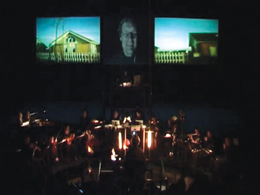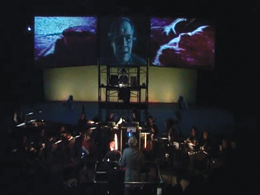Arts
Inside the Mind of a Madman

Joshua Fineberg
The incorporation of technology with creative expression is by no means unique to the visual arts. Composer Joshua Fineberg’s latest project, a multimedia adaptation of Vladimir Nabokov’s most notorious novel, not only required him to develop a score but also to design and perfect innovative computer technology necessary to realize his vision for Lolita. Fineberg, a visiting associate professor in the School of Music, is no stranger to the use of technology in musical compositions, both to help compose acoustic music and to create original sounds and situations. His production premiered in Marseille in April 2008.
Fineberg felt that music would be especially well suited to capturing the novel’s narrative voice, which possesses what he calls “the lyricism of a madman.” While previous dramatizations of Lolita focused on the novel’s plot, he instead sought to give his audience unprecedented access to the mental state of the protagonist, Humbert Humbert. Without an objective, omniscient narrator to guide them, readers experience the story only through Humbert’s bizarre and possibly delusional account. Fineberg wanted to achieve a similar effect onstage, in order to create what he calls an “imaginary opera.”



Scenes from the Marseille premiere of Fineberg’s opera Lolita, a multimedia adaptation of Nabokov’s classic novel.
Stills courtesy of Joshua Fineberg
Realizing that a traditional operatic score would not do, he began developing voice modification technology at IRCAM (Institut de Recherche et Coordination Acoustique/Musique), in Paris, with colleague Axel Roebel. They created software that separates a recorded voice into two components—a “source,” equivalent to the sound produced by the voicebox, and a “filter” that mimics the effect produced by resonation in the nasal cavity—in order to create hybrid human voices that sound as if they could not exist, yet still sound natural.
By digitally manipulating this source and filter, known as a “spectral envelope,” Fineberg can alter the speaking voice of one individual into a “sung” voice that can then be placed in the body of another. In Lolita, for example, he transforms a middle-aged man’s spoken words into song emanating from the virtual body of a young girl, creating an “impossible voice”—an ideal acoustic representation of Humbert’s inability to distinguish between fantasy and reality.
Visual components in the production also help to situate the audience within Humbert’s psyche. Lolita’s video artist, Kurt d’Haeseleer, and scenic designer, Jim Clayburgh, use video to highlight the performative nature of Humbert’s narration. Three video cameras record the actor playing Humbert, and the images they capture are projected live onto a semitransparent screen at center stage. Behind the screen, dancers, led by choreographer Johanne Saunier, give a corporal presence to Humbert’s fantasies.
Like any adaptation, Fineberg’s Lolita takes creative liberties. But by telling the story from Humbert’s perspective, Fineberg’s imaginary opera captures the spirit of Nabokov’s original in a revealing new way.